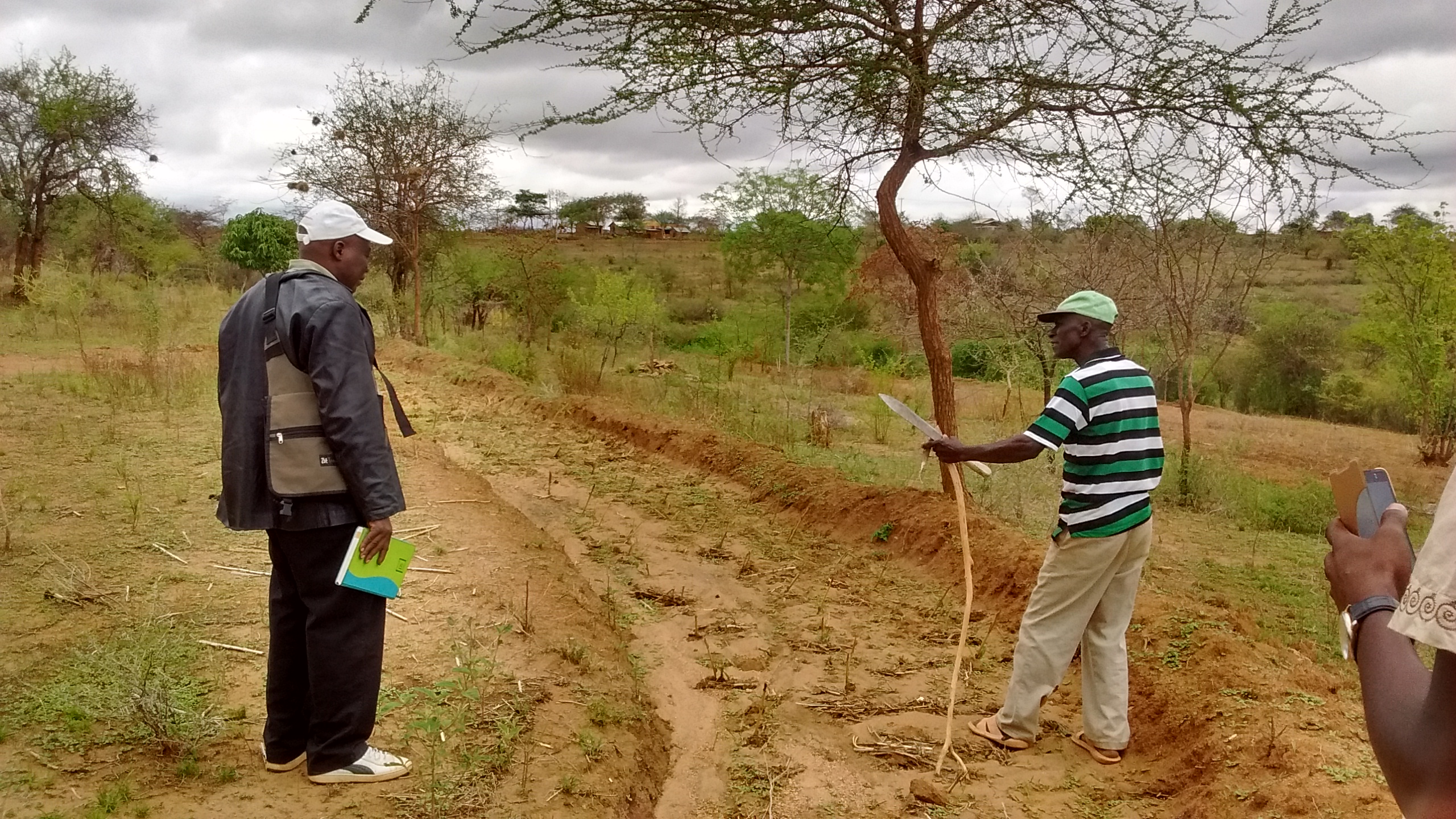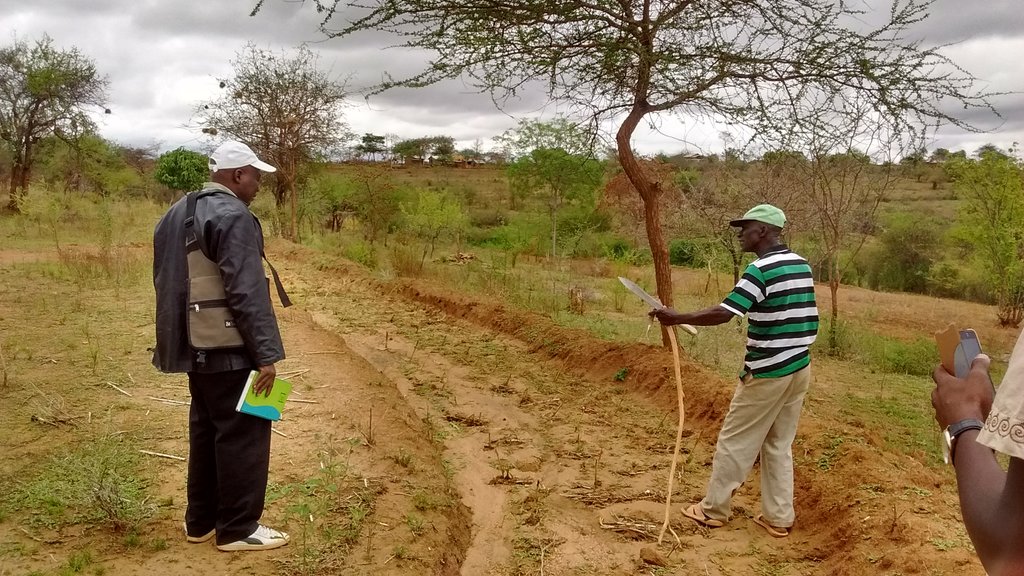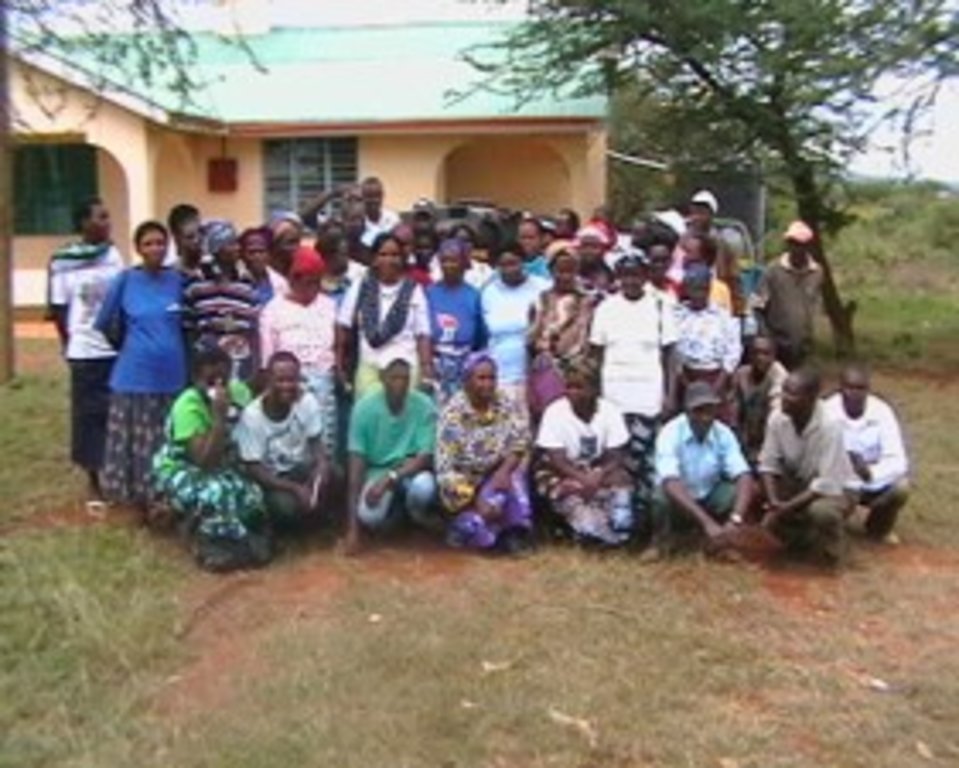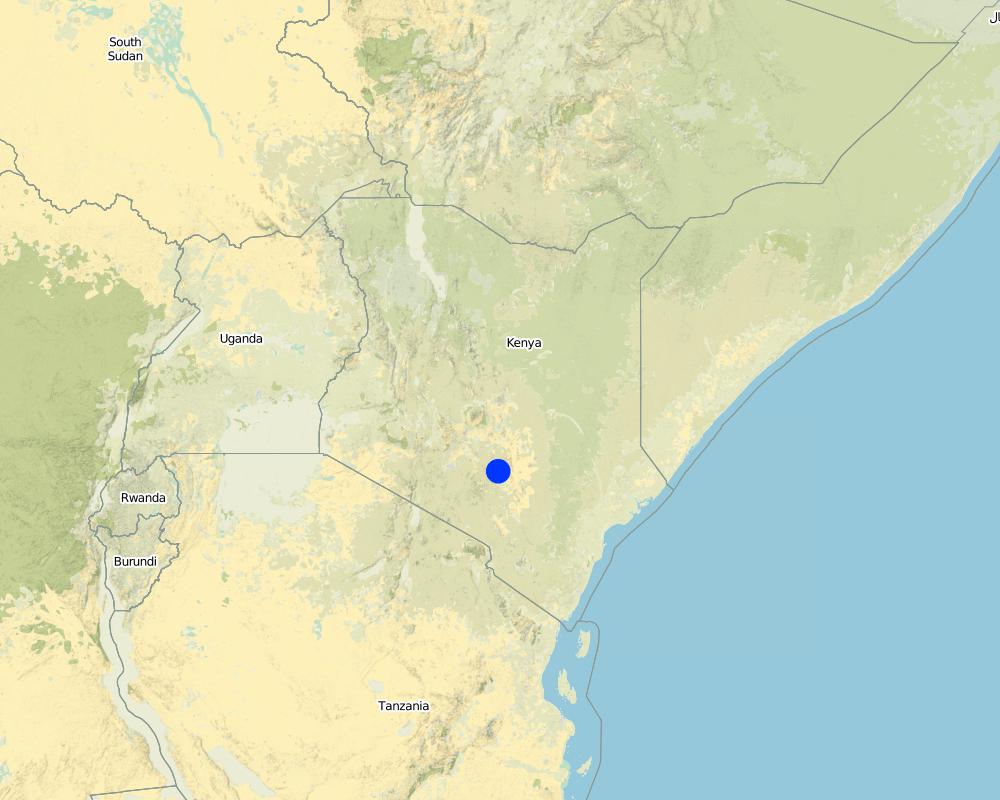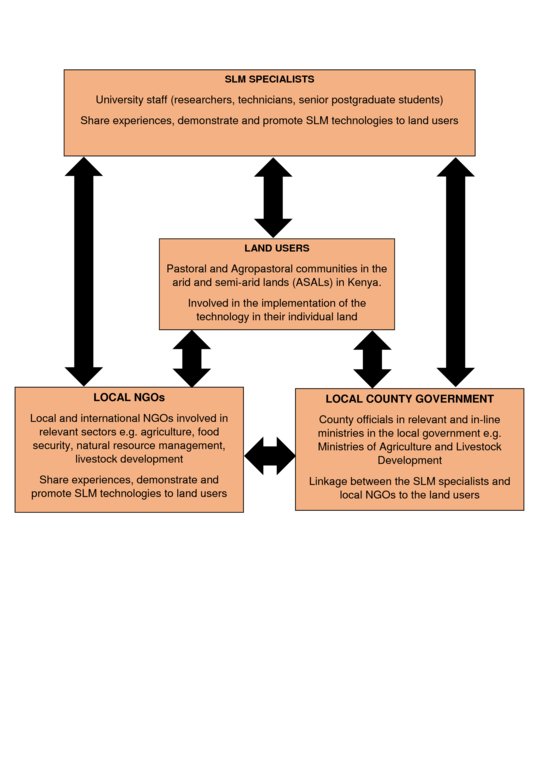On-farm indigenous pasture establishment demonstrations [Kenia]
- Creación:
- Actualización:
- Compilador: Kevin Mganga
- Editor: –
- Revisores: Rima Mekdaschi Studer, Hanspeter Liniger, Donia Mühlematter
On-farm demos
approaches_3285 - Kenia
- Resumen completo en PDF
- Resumen completo en PDF para imprimir
- Resumen completo en el navegador
- Resumen completo (sin formato)
- In-situ pasture establishment demonstrations: 26 de enero de 2018 (inactive)
- On-farm pasture establishment demonstrations : 21 de febrero de 2018 (inactive)
- On-farm indigenous pasture establishment demonstrations : 20 de abril de 2018 (inactive)
- On-farm indigenous pasture establishment demonstrations : 3 de septiembre de 2018 (public)
Visualizar secciones
Expandir todo Colapsar todos1. Información general
1.2 Detalles de contacto de las personas de referencia e instituciones involucradas en la evaluación y la documentación del Enfoque
Persona(s) de referencia clave/s
Especialista MST:
Nombre del proyecto que facilitó la documentación/ evaluación del Enfoque (si fuera relevante)
Book project: Guidelines to Rangeland Management in Sub-Saharan Africa (Rangeland Management)Nombre de la(s) institución(es) que facilitaron la documentación/ evaluación del Enfoque si fuera relevante)
Department of Range and Wildlife Sciences, South Eastern Kenya University (SEKU) - Kenia1.3 Condiciones referidas al uso de datos documentados mediante WOCAT
¿Cuándo se compilaron los datos (en el campo)?
10/11/2017
El compilador y la/s persona(s) de referencia claves aceptan las condiciones acerca del uso de los datos documentados mediante WOCAT :
Sí
1.4 Referencia/s al/los Cuestionario(s) de Tecnologías MST
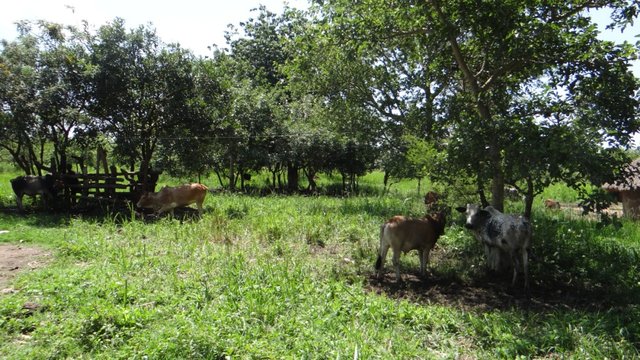
Multi-Purpose Tree Species for Pasture Supplementation [Uganda]
Multi-purpose tree species such as Calliandra calothyrsus are planted on farmstead to improve pastures for soil fertility improvement and livestock production
- Compilador: Sunday Balla Amale
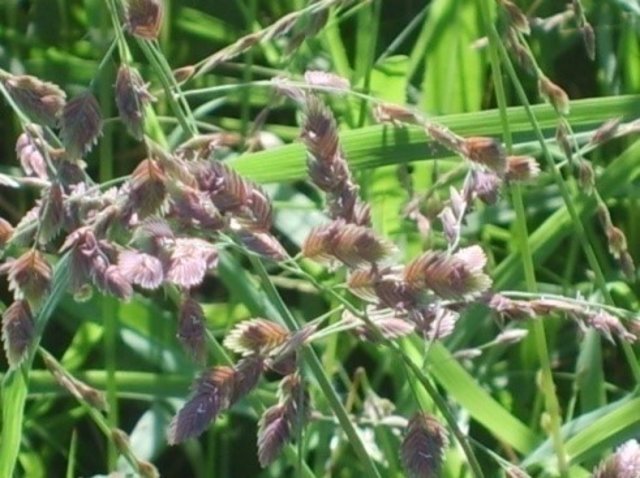
Grass reseeding [Kenia]
Grass reseeding is a sustainable land management practice aimed at rehabilitating degraded pastures and providing livestock feed. This is mainly carried out with indigenous perennial grass species.
- Compilador: Kevin Mganga
2. Descripción del Enfoque MST
2.1 Breve descripción del Enfoque
On-farm indigenous pasture establishment demonstrations offer a practical approach to encourage adoption in the arid and semi-arid environments in Kenya.
2.2 Descripción detallada del Enfoque MST
Descripción detallada del Enfoque MST:
The characteristic feature of the demonstration approach is the interaction of different stakeholders in on-farm showcasing of sustainable land management technologies. The stakeholders include land users, NGOs, SLM specialists, local government officials and university researchers. SLM specialists and university researchers, with the help of local government and NGO field officers demonstrate the entire process of grass reseeding from site selection, seedbed preparation, grass species selection, weeding, monitoring and evaluation of both plant and soil parameters. The method comprises on-farm demonstrations both at individual, and pastoral and agropastoral group sites, and a model demonstration site within the university premises. The role of the main stakeholders involved in the process are sharing the knowledge, skills and technology (the SLM specialists; researchers from the university), linking the SLM specialists with the pastoral communities, sharing their experiences through on-farm demonstrations and explanations of similar technologies local government (county officials), sharing knowledge of past experiences and skills (local NGOs). The end users of the technologies, namely the pastoral communities share their indigenous technical knowledge related to natural resource management. In this case study the end-users comprised approximately 40 livestock keepers. Over five visits and through the demonstrations, they liked the approach because it was more practical being on-farm (“seeing is believing”). It was appreciated as being easily replicated on their own land under the same local conditions of climate, soil type, grass species, methods of land preparation, and land use system. After interacting with the SLM specialists from the universities during the visits and on-farm demonstrations, land-users have adopted the technology to ensure a continuous supply of pasture for their livestock.
2.3 Fotos del Enfoque
Comentarios generales sobre las fotos:
Stakeholders discussing and sharing their knowledge and skills.
2.5 País/ región/ lugares donde el Enfoque fue aplicado
País:
Kenia
Región/ Estado/ Provincia:
Eastern Province
Especifique más el lugar :
Kitui municipality, Kitui county
Map
×2.6 Fechas de inicio y conclusión del Enfoque
Si no se conoce el año preciso, indique la fecha aproximada en la que se inició el Enfoque:
hace menos de 10 años (recientemente)
2.7 Tipo de Enfoque
- iniciativa local reciente/ innovadora
2.8 Propósitos/ objetivos principales del Enfoque
To demonstrate indigenous pasture establishment on-farm, and encourage land users to practice reseeding as a means of 1) rehabilitating their degraded lands, 2) providing forage for their livestock and 3) income generation through sale of surplus animal products i.e. milk, hay and seeds.
2.9 Condiciones que facilitan o impiden la implementación de la/s Tecnología/s aplicadas bajo el Enfoque
normas y valores sociales/ culturales/ religiosos
- facilitan
Land users are livestock keepers so technologies and approaches to improve livestock production are welcome.
- impiden
Gender-based constraints where men dominate on-farm training/demonstrations compared to female land users.
disponibilidad/ acceso a recursos y servicios financieros
- facilitan
Facilitation from previous (Agricultural Innovation for Dryland Africa, AIDA) and on-going research project (Rainwater Harvesting for Indigenous Pasture Production, ROFIP, in semi-arid Kitui County, Kenya). The current ROFIP project is under the Food and Business Applied Research Fund (ARF) funded by the he Netherlands Organisation for Scientific Research (NWO).
- impiden
Accessing money/financial resources from government/public institutions and organisation is long (much slower) due to e.g. bureaucracy and protocol, compared to private organisation (much faster access, less bureaucratic).
entorno institucional
- facilitan
The university encourages extension service delivery to the local community and supports such initiatives to reach out to land users to share knowledge and expertise.
- impiden
Coordinating different stakeholders both in the private (NGO) and public sector (university, local government), together with land users is often a challenge mainly due to the different nature of operations e.g. bureaucracy, protocol.
colaboración/ coordinación de actores
- facilitan
Collaboration between university, local government and local land users.
- impiden
Different stakeholders (e.g. land users, university, local government, NGOs) all have different key objectives to achieve within the general aim/objectives. This often hinders the coordination of actors and implementation of the approach.
marco de trabajo legal (tenencia de tierra, derechos de uso de tierra y agua)
- facilitan
Land used in the approach for demonstrating the reseeding technology is privately owned.
- impiden
Land ownership is private, communal and group. This determines the organisation and arrangement of the approach.
gobernanza de tierras (toma de decisiones, implementación y aplicación)
- facilitan
conocimiento de MST, acceso a apoyo técnico
- facilitan
SLM specialists have knowledge about the SLM technologies and various approaches.
mercados (para comprar insumos, vender productos) y precios
- facilitan
- impiden
Some of the inputs especially indigenous grass seeds, are not available in the formal seed market in Kenya. Reliance on the informal seed market often leads to the purchase and use of uncertified seeds with poor end results.
carga de trabajo, disponibilidad de mano de obra
- facilitan
Use of local casual labourers. This contributes to “ownership” of the project activities and easier implementation in their individual farms.
- impiden
Division of labour between the project demonstration sites and individual activities. This may lead to delays in implementing project activities.
3. Participación y roles de las partes interesadas involucradas
3.1 Partes interesadas involucradas en el Enfoque y sus roles
- usuarios locales de tierras/ comunidades locales
local land users and livestock keepers
Share their indigenous technical knowledge; provide land for on-farm demonstrations.
- especialistas MST/consejeros agrícolas
university researchers
Describe the technologies using practical on-farm demonstrations. Additionally, share and present scientific research findings to demonstrate the contribution of the use of the technology for increased indigenous pasture production: i.e. evidence-based.
- profesores/ niños en edad escolar/ estudiantes
university students
Practical demonstrations
- ONG
Local NGO (Roads for Water)
Collaborate with university researchers to demonstrate to different land users and managers (e.g. researchers, pastoral and agro-pastoral communities) how other land management strategies e.g. rainwater harvesting using roads as catchments can be incorporated in reseeding programmes to enhance pasture establishment, especially in dryland environments.
- gobierno local
Extension agents and advisors in the county government
Link to the end-users, share past experiences and knowledge on SLM approaches
3.2 Involucramiento de los usuarios locales de tierras/ comunidades locales en las distintas fases del Enfoque
| Involucramiento de los usuarios locales de tierras/ comunidades locales | Especifique quién se involucró y describa las actividades | |
|---|---|---|
| iniciación/ motivación | interactivo | Local land users involved in the site selection and involved in the plans of the project. Local land users share their indigenous technical knowledge gained through years of experience on aspects such as: which species are preferred by grazing animals (i.e. ranking of different forage species); which grass species perform better under different rainfall regimes, topography and soil types; which grass species are best suited for soil conservation and soil erosion control. |
| planificación | interactivo | Local land users actively involved in deciding on schedule for land users visits and demonstrations. Local land users participate and contribute to the planning of sowing dates, methods of land preparation, grass species selection in relation to their individual taste and preference and intended use (fodder for livestock, soil conservation and combating degradation, large-scale seed production). |
| implementación | interactivo | Demonstration conducted on individual 'farms'/ pastures and local land users implement the technologies as 'model land users'. |
| monitoreo y evaluación | interactivo | Constant communication through short message services (SMS) and telephone calls on progress and challenges as land users monitor changes, e.g. seed germination and seedling establishment. Local land users report this to the SLM specialists e.g. researchers in the university and post-graduate students involved in the projects. |
| Research | pasivo | Research is mainly conducted by SLM specialists at university and students. The local government is also involved in research since some of the students recruited to be part of the project: for example PhD and MSc students are permanently employed by the local government. Local land users share their indigenous technical knowledge through one-on-one informal discussions/sessions between them and the SLM specialists and students. |
3.3 Flujograma (si estuviera disponible)
Descripción:
Interaction between different stakeholders (SLM specialists, local government, local NGOs and land users) for pasture establishment demonstrations in arid and semi-arid environments in Kenya.
Autor:
Kevin Z. Mganga
3.4 La toma de decisiones en la selección de Tecnología(s) MST
Especifique quién decidió la selección de las Tecnología/ Tecnologías a implementarse:
- todos los actores relevantes, como parte de un enfoque participativo
Especifique las bases que sustentaron la toma de decisiones:
- la evaluación de conocimiento MST bien documentado (la toma de decisiones se basa en evidencia)
- hallazgos de investigaciones
- la experiencia personal y opiniones (no documentadas)
4. Apoyo técnico, fortalecimiento institucional y gestión del conocimiento
4.1 Construcción de capacidades / capacitación
¿Se proporcionó la capacitación a usuarios de tierras/ otras partes interesadas?
Sí
Especifique quién fue capacitado:
- usuarios de tierras
- personal de campo/ consejeros
Si fuese relevante, también especifique género, edad, estatus, etnicidad, etc.
The land users and field staff/advisers were drawn from both genders (male and female). University undergraduate students (both male and female students, between the ages of 20-24 years) were also involved in the training during on-farm practical sessions.
Forma de capacitación:
- áreas de demostración
Temas avanzados:
site selection, seedbed preparation, choice of grass species, monitoring and evaluation (plant and soil attributes), maintenance and further management.
4.2 Servicio de asesoría
¿Los usuarios de tierras tienen acceso a un servicio de asesoría?
Sí
Especifique si servicio proporcionado se realizó:
- en los campos de los usuarios de tierras
Describa/ comentarios:
Advisory services on-farm during visits.
4.3 Fortalecimiento institucional (desarrollo institucional)
¿Se establecieron o fortalecieron instituciones mediante el Enfoque?
- sí, moderadamente
Especifique el nivel o los niveles en los que se fortalecieron o establecieron las instituciones:
- local
- regional
- nacional
Describa la institución, roles y responsabilidades, miembros, etc.
University (South Eastern Kenya University, SEKU) - extension and outreach and research and academic exchange programs with other research institutions e.g. Kenya Agricultural and Livestock Research Organisation (KALRO), International Crops Research Institute for the Semi-Arid Tropics (ICRISAT), Kenya Seed Company, and other universities, for example the University of Nairobi (UoN).
Especifique el tipo de apoyo:
- financiero
- construcción de capacidades/ entrenamiento
Proporcione detalles adicionales:
Financial support from within university research funds and the National Research Fund (NRF), Kenya, through the Ministry of Education, Science and Technology. Capacity building through postgraduate training involving researchers from SEKU, KALRO, ICRISAT and UoN.
4.4 Monitoreo y evaluación
¿El monitoreo y la evaluación forman parte del Enfoque?
Sí
Comentarios:
Adoption and uptake of the technologies among land users.
Si respondió que sí, ¿la documentación se utilizará para monitoreo y evaluación?
Sí
Comentarios:
The approach demonstrates sustainable land management technologies e.g. grass reseeding, on farm. This is aimed at increasing adoption and spread of the technology by other land users.
4.5 Investigación
¿La investigación formó parte del Enfoque?
Sí
Especifique los temas:
- ecología
- tecnología
Proporcione detalles adicionales e indique quién hizo la investigación:
By an SLM specialist: that is researcher at the university under a research project.
5. Financiamiento y apoyo material externo
5.1 Presupuesto anual para el componente MST del Enfoque
Si no se conoce el presupuesto anual preciso, indique el rango:
- 2,000-10,000
Comentarios (ej. fuentes principales de financiamiento/ donantes principales):
Food and Business Applied Research Fund (ARF) funded by the The Netherlands Organisation for Scientific Research (NWO), Netherlands.
5.2 Apoyo financiero/material proporcionado a los usuarios de tierras
¿Los usuarios de tierras recibieron financiamiento/ apoyo material para implementar la Tecnología/ Tecnologías? :
Sí
Si respondió sí, especifique el tipo o los tipos de apoyo, condiciones y proveedor(es) :
Land and seed bed preparation: hiring of casual labour and rent of machinery / equipment (ox-plough / tractor).
5.3 Subsidios para insumos específicos (incluyendo mano de obra)
- mano de obra
| En qué grado | Especifique los subsidios |
|---|---|
| parcialmente financiado | Cash subsidy mainly for land/site preparation e.g. creating of micro-catchments using ox-driven ploughs, digging trenches as structures for rainwater harvesting. |
- equipo
| Especifique qué insumos se subsidiaron | En qué grado | Especifique los subsidios |
|---|---|---|
| maquinaria | totalmente financiado | Ox-driven ploughs for site preparation. Occasionally tractors. |
| herramientas | totalmente financiado | Hand hoes for bush clearing and site preparation. |
- agrícola
| Especifique qué insumos se subsidiaron | En qué grado | Especifique los subsidios |
|---|---|---|
| semillas | totalmente financiado | Indigenous grass seeds used in the technology and approach are provided for by the project. However, seed for subsequent sowing is expected to be harvested from the established pasture sites. |
Si la mano de obra de usuarios de tierras fue un insumo sustancial, ¿fue:
- voluntario?
Comentarios:
This is mainly for maintaining, monitoring and evaluation of the on-farm sites e.g. aspects of maintaining the fence to keep of free-ranging livestock from damaging the established pastures and assisting other hired labourers e.g. in seeding.
5.4 Crédito
¿Se proporcionó crédito bajo el Enfoque para actividades MST?
No
5.5 Otros incentivos o instrumentos
¿Se usaron otros incentivos o instrumentos para promover la implementación de Tecnologías MST?
No
6. Análisis de impacto y comentarios de conclusión
6.1 Impactos del Enfoque
¿El Enfoque empoderó a los usuarios locales de tierras, mejoró el involucramiento de las partes interesadas?
- No
- Sí, un poco
- Sí, moderadamente
- Sí, mucho
They owned and embraced the initiative since it involved them from the onset.
¿El Enfoque facilitó la toma de decisiones basada en evidencia?
- No
- Sí, un poco
- Sí, moderadamente
- Sí, mucho
On-farm sites are used for both demonstrations and experimental plots for research. This is mainly conducted by SLM specialists from the university and postgraduate students in close collaboration with land users (e.g. farmers) aimed at comparing different treatments for the technologies.
¿El Enfoque ayudó a los usuarios de tierras a implementar y mantener Tecnologías MST?
- No
- Sí, un poco
- Sí, moderadamente
- Sí, mucho
Practical on-farm demonstrations in their individual farms.
¿El Enfoque mejoró la coordinación e implementación efectiva en costos de MST?
- No
- Sí, un poco
- Sí, moderadamente
- Sí, mucho
Communication through SMS and phone calls, exchange of photos/videos of demonstrations through WhatsApp groups and emails.
¿El Enfoque movilizó/mejoró el acceso a recursos financieros para implementar MST?
- No
- Sí, un poco
- Sí, moderadamente
- Sí, mucho
Joint research grants and funds through collaborative work among stakeholders mostly between local NGOs and universities.
¿El Enfoque mejoró el conocimiento y capacidades de los usuarios para implementar MST?
- No
- Sí, un poco
- Sí, moderadamente
- Sí, mucho
Through practical and hands-on on-farm demonstrations by SLM specialists.
¿El Enfoque mejoró el conocimiento y capacidades de otras partes interesadas?
- No
- Sí, un poco
- Sí, moderadamente
- Sí, mucho
Local government and NGOs appreciating the technologies and serve as ambassadors of the same.
¿El Enfoque construyó/ fortaleció instituciones, colaboración entre partes interesadas?
- No
- Sí, un poco
- Sí, moderadamente
- Sí, mucho
Collaboration between universities, local government, local NGOs and land users strengthened.
¿El Enfoque mitigó conflictos?
- No
- Sí, un poco
- Sí, moderadamente
- Sí, mucho
¿El Enfoque empoderó a grupos en desventaja social y económica?
- No
- Sí, un poco
- Sí, moderadamente
- Sí, mucho
¿El Enfoque mejoró la equidad de género y empoderó a las mujeres y niñas?
- No
- Sí, un poco
- Sí, moderadamente
- Sí, mucho
Female land users involved.
¿El Enfoque alentó a jóvenes/ la siguiente generación de usuarios de tierras a involucrarse con MST?
- No
- Sí, un poco
- Sí, moderadamente
- Sí, mucho
Young farmers involved. Also students in universities as part of practical field work.
¿El Enfoque resultó en mejor seguridad alimentaria/ mejoró la nutrición?
- No
- Sí, un poco
- Sí, moderadamente
- Sí, mucho
Improved pasture production for livestock, healthy animals.
¿El Enfoque mejoró el acceso a los mercados?
- No
- Sí, un poco
- Sí, moderadamente
- Sí, mucho
Market for sale of grass seeds.
¿El Enfoque mejoró la capacidad de los usuarios de tierras a adaptarse a los cambios climáticos/ extemos y mitigar desastres relacionados al clima?
- No
- Sí, un poco
- Sí, moderadamente
- Sí, mucho
Combining the use of indigenous drought tolerant grass species and water harvesting.
¿El Enfoque llevó a oportunidades de empleo, ingresos?
- No
- Sí, un poco
- Sí, moderadamente
- Sí, mucho
Through sale of grass seeds and hay, surplus animal products (mostly milk) in seasons of plenty.
6.2 Motivación principal del usuario de la tierra para implementar MST
- producción incrementada
Increased pasture yields (improved livestock production)
- incremento de la renta(bilidad), proporción mejorada de costo-beneficio
Sale of grass seeds and hay and surplus animal products e.g. milk and healthy animals at a good market price
- reducción de la degradación del suelo
Established pastureland reduces soil erosion and contributes to enhanced soil moisture and C-sequestration (soil ecosystem services).
- conciencia medioambiental
Environmental conservation
6.3 Sostenibilidad de las actividades del Enfoque
¿Pueden los usuarios de tierras sostener lo que se implementó mediante el Enfoque (sin apoyo externo)?
- sí
Si respondió que sí, describa cómo:
Approach is practical and involves the use of already existing knowledge and skills e.g. use of ox-ploughs for site preparation is not foreign; local land users have interacted through their knowledge of the indigenous grasses.
6.4 Fortalezas/ ventajas del Enfoque
| Fuerzas/ ventajas/ oportunidades desde la perspectiva del usuario de la tierra |
|---|
| Ease of understanding and appreciation because of its practical nature. |
| Approach allows a close interaction and exchange between the different stakeholders (land users, NGOs, local government officials, SLM specialists, universities) i.e. provides a science-practice link; learning by doing. |
| Fuerzas/ ventajas/ oportunidades desde la perspectiva del compilador o de otra persona de referencia clave |
|---|
| On-farm and practical approach for easy adoption by other land users. |
| Takes advantage of group dynamics where different stakeholders share and provide immediate feedback and seek clarification throughout the process thus enriching the discussions. |
6.5 Debilidades/ desventajas del Enfoque y formas de sobreponerse a ellos
| Debilidades/ desventajas/ riesgos desde la perspectiva del usuario de la tierra | ¿Cómo sobreponerse a ellas? |
|---|---|
| Source of conflict between land user where the on-farm demonstration has been conducted and other neighbouring land users e.g. diverting runoff in the upland thus reducing the volume of rainwater reaching farms located down-slope. | Continuous capacity building, knowledge sharing and sensitization. |
| Choice of on-farm demonstration site at an individual land owner can lead to jealousies among other land users. Choice of on-farm demonstration site at an individual land owner can lead to aggravation among other land users. | Use of communal or group owned land for on-farm demonstrations. |
| Allocation of time to attend the on-farm demonstrations. The approach is often conducted before the onset of the rains, when the land users are busy preparing their own farms for sowing. This might lead to low turn-out during demonstrations. | In consultation with the land users, set the date(s) when majority of the land users are available. |
| Debilidades/ desventajas/ riesgos desde la perspectiva del compilador o de otra persona de referencia clave | ¿Cómo sobreponerse a ellas? |
|---|---|
| Language barrier (SLM specialists and land users). | Involving a local land user/personnel to bridge the gap. |
7. Referencias y vínculos
7.1 Métodos/ fuentes de información
- visitas de campo, encuestas de campo
20
- entrevistas con usuarios de tierras
50
7.2 Referencias a publicaciones disponibles
Título, autor, año, ISBN:
KZ Mganga, NKR Musimba, DM Nyariki. 2015. Competition indices of three perennial grasses used to rehabilitate degraded semi-arid rangelands in Kenya. The Rangelands Journal 37: 489-495
¿Dónde se halla disponible? ¿Costo?
The Rangeland Journal, USD 25
Título, autor, año, ISBN:
KZ Mganga, NKR Musimba, DM Nyariki. 2015. Combining sustainable land management technologies to combat land degradation and improve rural livelihoods in semi-arid lands in Kenya. Environmental Management 56: 1538-1548
¿Dónde se halla disponible? ¿Costo?
Environmental Management, USD 38
Título, autor, año, ISBN:
KZ Mganga, NKR Musimba, MM Nyangito, DM Nyariki, AW Mwang’ombe. 2015. The choice of grass species to combat desertification in semi-arid Kenyan rangelands is greatly influenced by their forage value for livestock. Grass and Forage Science 70: 161-167.
¿Dónde se halla disponible? ¿Costo?
Grass and Forage Science, USD 38
7.3 Vínculos a la información relevante disponible en línea
Título/ descripción:
Competition indices of three perennial grasses used to rehabilitate degraded semi-arid rangelands in Kenya
URL:
http://www.publish.csiro.au/rj/RJ15023
Título/ descripción:
Combining sustainable land management technologies to combat land degradation and improve rural livelihoods in semi-arid lands in Kenya
URL:
https://link.springer.com/article/10.1007/s00267-015-0579-9
Título/ descripción:
The choice of grass species to combat desertication in semi-arid Kenyan rangelands is greatly inuenced by their forage value for livestock
URL:
http://onlinelibrary.wiley.com/doi/10.1111/gfs.12089/abstract
Vínculos y módulos
Expandir todo Colapsar todosVínculos

Multi-Purpose Tree Species for Pasture Supplementation [Uganda]
Multi-purpose tree species such as Calliandra calothyrsus are planted on farmstead to improve pastures for soil fertility improvement and livestock production
- Compilador: Sunday Balla Amale

Grass reseeding [Kenia]
Grass reseeding is a sustainable land management practice aimed at rehabilitating degraded pastures and providing livestock feed. This is mainly carried out with indigenous perennial grass species.
- Compilador: Kevin Mganga
Módulos
No se hallaron módulos


